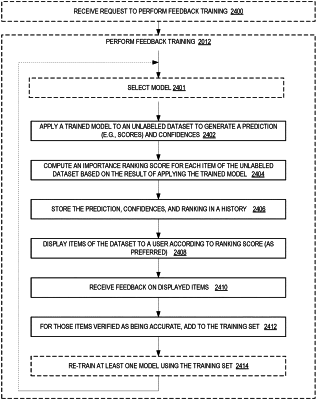| CPC G06F 18/2148 (2023.01) [G06F 9/451 (2018.02); G06F 18/2155 (2023.01); G06F 18/2178 (2023.01); G06N 3/088 (2013.01); G06N 3/09 (2023.01); G06N 20/00 (2019.01); G06V 10/70 (2022.01); G06V 10/7753 (2022.01); G06V 10/7784 (2022.01); H04L 63/1425 (2013.01); G06T 2207/20081 (2013.01)] | 20 Claims |

|
4. A computer-implemented method comprising:
receiving one or more requests to train an anomaly detection machine learning model using feedback-based training, the request to indicate one or more of a type of analysis to perform, a model selection indication, and a configuration for a training dataset;
training the anomaly detection machine learning model according to the one or more requests using the training data to generate a trained anomaly detection machine learning model; and
performing feedback-based training on the trained anomaly detection machine learning model by at least:
applying the trained anomaly detection machine learning model on a set of testing data that is different than the training data to generate a prediction of whether the testing data is anomalous,
presenting a graphical user interface showing results of the prediction including at least indications of which items of the testing dataset were determined to be anomalous, an anomaly score for each item, and the item itself;
receiving feedback on the prediction, wherein the feedback includes an indication of a veracity of the prediction,
updating the training data to include a label for correctly predicted data of the unlabeled testing data based on the received feedback, and
retraining the trained anomaly detection machine learning model using the updated training data to generate a retrained anomaly detection machine learning model.
|